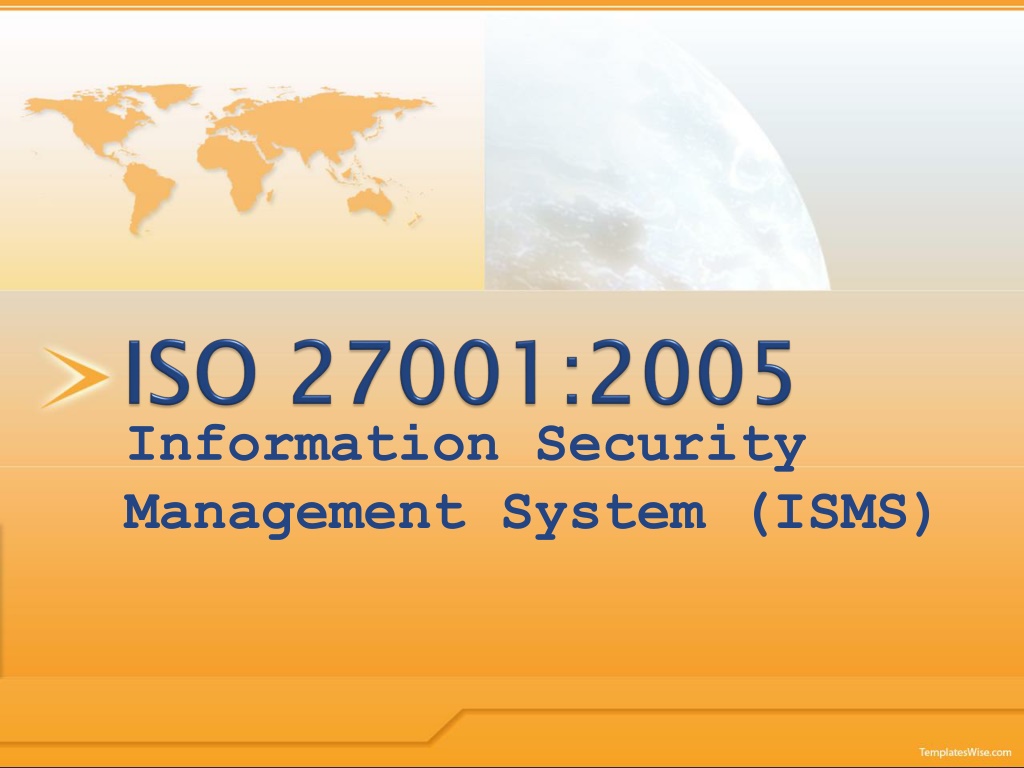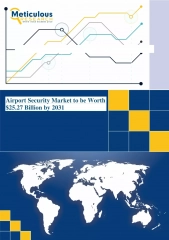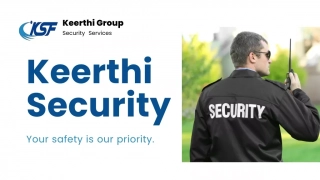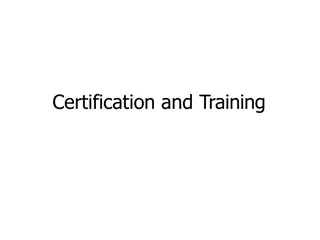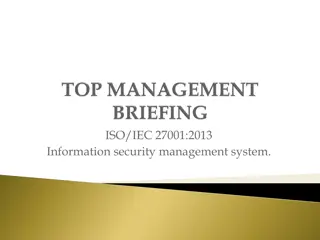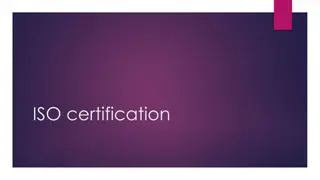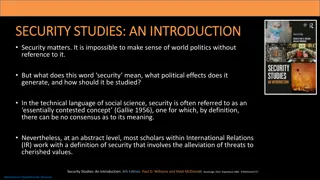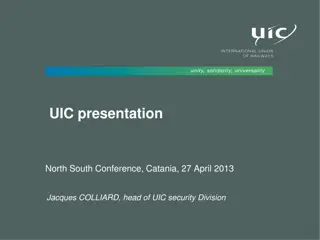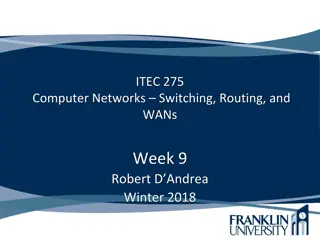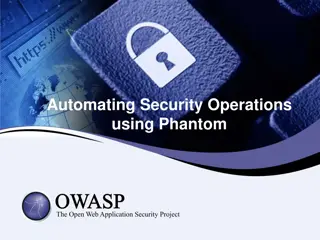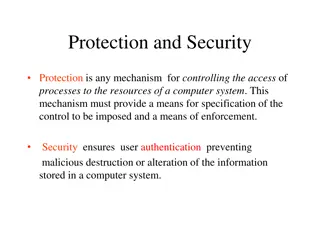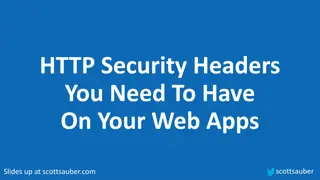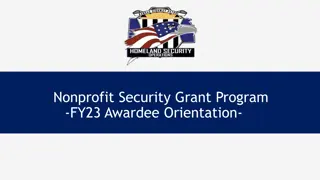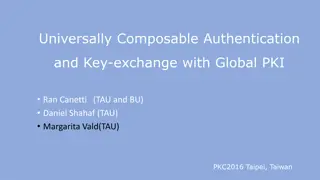Information Security Management System (ISMS)
Understanding the evolution and implementation of Information Security Management System (ISMS) and ISO 27001 standard, covering its purpose, requirements, risk approach, global impact, certification history, and related standards like ISO 17799. The content delves into the development timeline, key editions, and the importance of information security practices in various domains.
Download Presentation

Please find below an Image/Link to download the presentation.
The content on the website is provided AS IS for your information and personal use only. It may not be sold, licensed, or shared on other websites without obtaining consent from the author. Download presentation by click this link. If you encounter any issues during the download, it is possible that the publisher has removed the file from their server.
E N D
Presentation Transcript
Information Security Management System (ISMS)
Introduction to ISO 27001 Purpose and intent of the 27001 standard Requirements of ISO 27001:2005
That part of the overall management system, based on a business risk approach, to establish, implement, operate, monitor, review, maintain and improve information security. (ISO/IEC 27001:2005 Clause 3.7)
That part of the overall management system, based on a business risk approach, to establish, implement, operate, monitor, review, maintain and improve information security. (ISO/IEC 27001:2005 Clause 3.7)
Escalating Risk Insurance Globalization Risk tolerance Societal values Legislation Government Neighbor INFORMATION SECURITY MANAGEMENT INFORMATION SECURITY MANAGEMENT NGOs Competition- business Competition - cost Consumer Corporate culture Customer requirements Employee Shareholder Union Corporate vision & policy
Early 1990s Dept. of Trade and Industry of UK support to develop 1995 First adopted as British Standard (BS) 1998 Certification requirements launched 1999 Second Edition issued Added e-commerce, m-computer and contract of 3rdparty 2000 ISO approved ISO 17799 Part 1 in Aug
2002 BS 7799-2:2002 issued on Sept. 5th Emphasis consistence with ISO 9001& ISO 14001 Adopted PDCA Model 2003 Over 500 certificated issued 2004 Over 1,000+ certificated worldwide 2005 ISO 27001 released
ISO 17799 Code of practice for information security management ISO 27001:2005 Information technology security techniques Information security management systems requirements
ISO/IEC 15408 Information Technology security techniques evaluation criteria ISO/IEC 12207 Software life cycle processes ISO/IEC 18045 Methodology for IT Security evaluation ISO/IEC 13569 Banking and related financial services information security guidelines ISO/IEC TR 13335 Information technology guidelines for the management of IT security
ISO/IEC TR 15504 Software process assessment BS ISO/IEC 90003:2004 Software engineering. Guidelines for the application of ISO 9001:2000 to computer software. TickIT V5.0 using ISO 9001:2000 for software quality management system construction, certification and continual improvement. BS 15000 IT service management
ISO 9001 Quality Management Systems requirements ISO 14001 Environmental Management Systems specification with guidance for use
PURPOSE OF ISO 27001 PURPOSE OF ISO 27001
To protect an organizations information assets in order to: ensure business continuity, minimize business damage, and maximize return on investments Internationally recognized, structured methodology Defined process to evaluate, implement, maintain, and manage information security, Tailored policies, standards, procedures, and guidelines
Efficient and effective security planning and management Increased credibility, trust and confidence of partners and customers Compliance to all relevant commitment Compatibility with other standards
Accountability Non-Repudiation Confidentiality Availability Reliability Accountability Integrity
Take actions to continually improve process performance effectiveness and efficiency Establish objectives necessary to deliver results in accordance with customer requirements and the organization s policies Monitor and measure processes and product against policies, objectives and requirements Implement the processes
1 Scope 1.1 General 1.2 Application 2 Normative References 3 Term and definitions 4 Information security management system 4.1 General requirements 4.2 Establishing and managing the ISMS 4.3 Documentation requirements
5 Management Responsibility 5.1 Management commitment 5.2 Resource management 6 Internal ISMS audits 7 Management review of the ISMS 7.1 General 7.2 Review input 7.3 Review output
8 ISMS Improvement 8.1 Continual improvement 8.2 Corrective action 8.3 Preventive action
Annex A (normative) Control objectives and controls Annex B (informative) OECD principles and this International Standard Annex C (informative) Correspondence between BS EN ISO 9001:2000, BS EN ISO 14001:1996 and ISO 27001:2005
Requirements for Establishing Implementing Operating Monitoring Reviewing Maintaining and Improving A documented ISMS w/in the context of the organization s overall business risks
ISMS is designed to ensure the selection of adequate and proportionate security controls that protect information assets and give confidence to interested parties.
Generic Applicable to all organizations Exclusions: do not affect the ability or responsibility to provide information security that meets security requirements as determined by risk assessment and regulatory requirements must be justified and evidence provided that associate risks are acceptable Requirements in clauses 4, 5, 6, 7 and 8 cannot be excluded
4 Information Security Management System 4.2 Establish and manage the ISMS 4.3 4.1 Documentation requirements 4.3.1 General General Requirements 4.2.1 Establishing the ISMS 4.2.2 Implement and operate the ISMS 4.1 Monitor and review the ISMS 4.1 Maintain and improve the ISMS 4.3.2 Control of documents 4.3.3 Control of records
Establish the ISMS Implement the ISMS Operate the ISMS Monitor the ISMS Review the ISMS Maintain the ISMS Improve the ISMS
4.2.1 Establish the ISMS a. Define the scope and boundaries of the ISMS b. Define and ISMS policy that: includes the framework for setting objectives and establishes an overall sense of direction takes into account business and legal requirements, and contractual security obligations aligns with the strategic risk management context establishes criteria against which risk will be evaluated has been approved by management
4.2.1 Establish the ISMS c. Risk assessment approach suited to the ISMS, and the identified business information security, legal and regulatory requirements criteria for accepting risks and identify the acceptable levels of risks d. Risk identification assets w/in the scope of the ISMS, and the owners of these assets threats to those assets vulnerabilities that might be exploited by the threats impacts that losses of confidentiality, integrity and availability may have on the assets
Information assets Database Procedures Training material Paper documents Inventory list Contracts Software assets Application software System software Case too Physical assets Computers Fax machines Air-conditioning units Building Network devices Goods People Service Intangibles Money Staffs Customers Subscribers Heating Network Telecom Power Air-condition Pipe water Goodwill / reputation Organization confidence Organization image
4.2.1 Establish the ISMS c. Risk analysis Business impacts upon the organization that might result from security failures Realistic likelihood of security failures occurring and controls currently implemented Estimate he levels of risks Determine whether the risks are acceptable or require treatment d. Risk treatment Applying appropriate controls Accepting risks Avoiding risks Transferring risks to other parties, e.g. insurers
4.2.1 Establish the ISMS c. Select control objectives (ref. Annex A) d. Residual risks and management approval e. Authorization to implement f. Statement applicability Control objectives and controls selected Control objectives and controls currently implemented Exclusion of any control objectives and controls and the justification for their exclusion
4.2.2 Implement and operate a. Formulate Risk Treatment Action Plan b. Implement Risk Treatment Action Plan c. Implement controls selected d. Define how to measure the effectiveness of the controls e. Implement training and awareness programmes f. Manage Operations g. Manage Resources h. Information Security Incidents and Response
4.2.3 Monitor and Review a. Execute monitoring and reviewing procedures b. Review effectiveness of the ISMS c. Measure the effectiveness of controls d. Review risk assessments at planned intervals e. Conduct internal ISMS audits at planned intervals f. Undertake a management review of the ISMS g. Update security plans h. Records actions and events that could have an impact on the performance of the ISMS
4.2.4 Maintain and improve a. Implement the identified improvements b. Take CA/PA c. Communicate improvements d. Ensure improvements achieve intended objectives
4.3.1 General a. b. Scope of the ISMS c. Mandatory procedures: control of documents, internal ISMS audits, corrective action, preventive action d. Description of risk assessment methodology e. f. g. The mandatory documented procedures h. Records i. The extent of the documentation will depend upon the size of organization and type of activities, scope, and complexity of security requirements and the system being managed. Documented statements of security policy and objectives Procedures and controls to support ISMS Risk assessment report Risk treatment plan Statement of applicability
4.3.2 Control of documents a. Approved documents for adequacy prior to issue b. Review and updated documents as necessary and re-approve documents c. Ensure that changes and the current revision status are identified d. Ensure that relevant versions are available at points of use e. Legible and readily identifiable f. Documents are available to those who need them g. Documents of external origin are identified
4.3.2 Control of documents h. Distribution of documents is controlled i. Prevent unintended use of obsolete documents j. Identification of obsolete documents
4.3.3 Control of records Establish conformity to the requirements and effective operation of ISMS Should be controlled legible readily identifiable retrievable Ex: visitors book, audit reports and completed authorization forms
5 Management responsibility 5.1 5.2 Management commitment Resource management 5.2.1 Provision of resources 5.2.2 Training, awareness and competence
Shall provide evidence: a. b. Objectives and plans c. d. Communicating to the organization the importance of meeting the objectives and conforming to the policy, responsibilities under the law, and need for continual improvement e. f. levels of risk g. ISMS audits are conducted h. Conducting management review Establish ISMS policy Roles and responsibilities Sufficient resources Deciding the criteria for accepting risks and acceptable
5.2.1 Provision of Resources The organization shall determine and provide resources needed 5.2.2 Training, awareness and competence a. Determine the competencies for personnel b. Providing training or taking other actions to satisfy these needs c. Evaluating effectiveness of the actions d. Maintaining records of education, training, skills, experience and qualifications
6.0 Internal ISMS audit Planned intervals to determine: Conformance to the standard and relevant legislations and regulations Conformance to ISMS Effectiveness of implementation Performance against plans Criticality or importance of process Auditor qualification Auditor independence Corrective action ISO 19011:2002
Authority for programme Establish programme: objectives/extent procedure resources responsibilities Plan Improve programme Act Implement programme: Schedule audits Develop audit plans Evaluate auditors Select audit teams Direct audit activities Maintain records Do Monitor and review programme Check
7 Management Review of the ISMS 7.1 General 7.2 Review input 7.3 Review output
Management shall review the organizations ISMS: Frequency Opportunities for improvement Documented and records maintained
Management review input shall include: a. Results of ISMS audits and reviews b. Feedback from interested parties c. Techniques, products or procedures, which could be used in the organization to improve the ISMS performance and effectiveness d. Status of preventive and corrective actions e. Vulnerabilities or threats not adequately addressed in the previously risk assessment f. Results from effectiveness measurements g. Follow-up actions from previous management reviews h. Any changes that could affect the ISMS i. Recommendations for improvement
Management review output shall include: a. Improvement of the effectiveness of the ISMS b. Update of the risk assessment and the risk treatment plan c. Modification of procedures and controls that effect information security d. Resource needs e. Improvement to how the effectiveness of the controls is being measured
8 ISMS Improvement 8.1 Continual improvement 8.2 Corrective action 8.3 Preventive action
